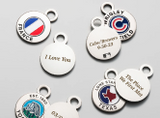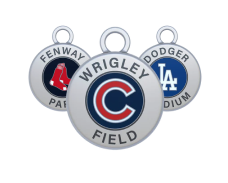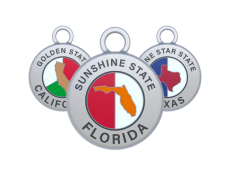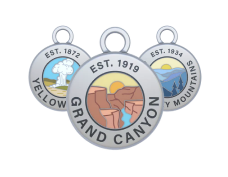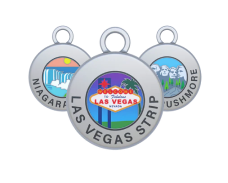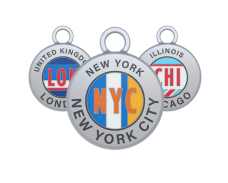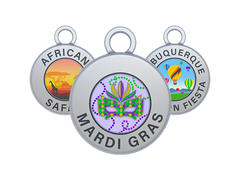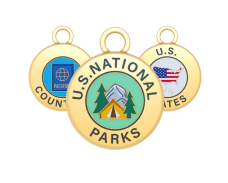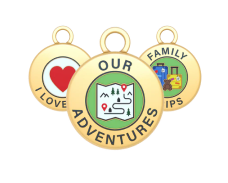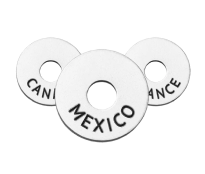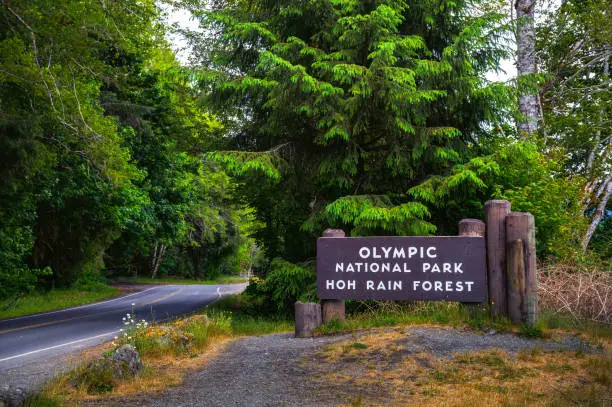
Key Takeaways:
- Rain Forest to Ridge: Build a day-friendly plan that moves from the Hoh Rain Forest to Hurricane Ridge, then winds down on the wild coast for sunset.
- Coast = Tides: Tide charts and low-tide timing matter for Rialto’s Hole‑in‑the‑Wall and the Ozette coast; some headlands are impassable at high tide.
- Permits & Prep: Overnight trips need wilderness permits, and Shi Shi Beach requires a Makah Recreation Pass for trailhead parking; always check current road and trail conditions.
If you’re mapping out things to do in Olympic National Park, this guide will help you see the park’s greatest hits without the overwhelm. In a single day, you can wander dew‑laden rain forests, climb to ridge‑line views, and finish at a driftwood‑strewn beach as the sun slips behind sea stacks.
At The Wandering Club, we help travelers collect their adventures without clutter. Choose a National Park Token for each place you visit, clip them to a Wanderchain or your favorite Token Holder, and personalize the back: two lines, 15 characters per line (30 total), with your date, trail, or inside joke. A portion of every order is donated to supporting charitable causes.
In this article, you’ll learn which stops belong on every first‑timer’s list, how to pace a one‑ to three‑day itinerary, and what seasonal details matter, like low‑tide windows on the coast and summer weekend congestion at popular trailheads. We’ll also flag permit and parking nuances so you can plan with confidence.
How To Choose The Best Things To Do In Olympic National Park
With three distinct ecosystems, glaciated mountains, temperate rain forests, and a wild Pacific coastline, Olympic rewards simple, well‑sequenced days. The list below starts near Port Angeles for easy access and loops clockwise to coastal and southern highlights. Mix one or two short hikes with a viewpoint or beach stop, and you’ll get the “Olympic sampler” without rushing.
1. Hurricane Ridge & The Hurricane Hill Trail
On clear days, Hurricane Ridge delivers sweeping views of the Olympic Mountains and, to the north, the Strait of Juan de Fuca. A paved, family‑friendly climb up Hurricane Hill (3–3.4 miles round trip) adds wildflowers in summer and the chance to spot deer and marmots. Go early for parking and bring layers—the wind up here earns the ridge its name.
2. Walk The Hoh Rain Forest: Hall Of Mosses & Spruce Nature Trail
Immerse yourself in a cathedral of big‑leaf maples and Sitka spruce draped in green. The Hall of Mosses (0.8‑mile loop) and Spruce Nature Trail (1.2 miles) start near the Hoh Rain Forest Visitor Center and deliver that storybook, moss‑on‑every‑surface feel with minimal effort.
3. Rialto Beach & Hole‑In‑The‑Wall Tidepools
From the end of Mora Road, stroll the pebbly shore of Rialto Beach toward the sea‑arch at Hole‑in‑the‑Wall (about 1.5 miles one way). Time your walk for low tide to safely pass the headland and linger among tidepools filled with anemones and sea stars. If the tide isn’t cooperating, enjoy the surf and driftwood closer to the trailhead.
4. Ruby Beach For Sea Stacks & Sunset
Iconic Ruby Beach pairs easy access with dramatic sea stacks, bleached driftwood, and fiery sunsets when clouds cooperate. It’s a great stop between the Hoh Rain Forest and Lake Quinault or as a final coastal unwind after a ridge or waterfall day. Watch footing on wet cobbles and keep an eye on incoming tides.
5. Lake Crescent & Marymere Falls
Deep and brilliantly blue, Lake Crescent anchors the park’s north side. Stretch your legs on the gentle walk to Marymere Falls (about 1.8 miles round trip), or linger on the lakeshore with a picnic. If paddling calls your name, rent a canoe or kayak from the concession at Lake Crescent Lodge in season.
6. Sol Duc Falls (Short Hike, Big Payoff)
A classic, family‑friendly stroll through old‑growth forest leads to Sol Duc Falls, where multiple channels plunge into a mossy gorge. The walk from the parking area is roughly 0.8 miles each way on a well‑graded path. Stay behind railings at viewpoints; slippery rocks near the brink are dangerous.
7. Day Hike The Ozette Triangle (Cape Alava → Sand Point Loop)
For a full‑value day, hike wooden boardwalks through coastal forest to Cape Alava, then traverse beach to Sand Point and return inland (about 9 miles). Expect sea stacks, tidepools, and seabirds, and mind the tide chart so headlands remain passable. This route also makes a terrific beginner backpack with a wilderness permit.
8. Shi Shi Beach & Point Of The Arches (Permit Notes)
Wild and remote, Shi Shi Beach rewards a longer drive with one of the park’s most photogenic coastlines. Access crosses the Makah Reservation; you’ll need a Makah Recreation Pass for trailhead parking, and an Olympic wilderness permit if camping. Aim for low tide to wander the tidepools and the sculpted Point of the Arches.
9. Staircase Rapids Loop (South Side)
On the park’s quieter southeast corner near Lake Cushman, the Staircase Rapids Loop (about 2 miles) meanders along the North Fork Skokomish River under towering Douglas‑fir and cedar. It’s a fantastic first hike, lush, loud with river sound, and doable for most fitness levels. Pair it with a picnic or an easy add‑on to Big Cedar.
10. Paddle Lake Crescent (Calm‑Water Adventure)
When winds are light, Lake Crescent is perfect for canoeing, kayaking, or paddleboarding. Early mornings are typically glassy, with mirror‑like reflections of the surrounding peaks. Rentals are offered in season at Lake Crescent Lodge, or you can bring your own gear and launch from designated areas.
Practical Tips For Your Olympic Trip
Before you stack your day with stops, a few logistics will keep things smooth: parking fills early at Hurricane Ridge and busy trailheads; tides dictate coastal timing; and some areas require specific permits. Download offline maps, pack the Ten Essentials, and check current road, trail, and weather updates the morning you head out.
- Know The Tides: Plan Rialto/Hole‑in‑the‑Wall and coastal hikes around low tide; some headlands are impassable at high tide.
- Permits: Overnight trips require an Olympic wilderness permit; coastal overnights often require bear canisters.
- Makah Recreation Pass: Needed for parking at Shi Shi access points on the Makah Reservation.
- Road Conditions: Mountain and coastal roads can close or constrict due to storms, maintenance, or winter weather—always verify day‑of conditions.
- Pets: Leashed pets are allowed only in limited areas; many trails and beaches are off‑limits within the park.
Dialing in these basics lets you focus on the magic, moss‑draped rain forests, sweeping ridgelines, and tide‑polished beaches, without the scramble.
Bring The Memories Home (The Wandering Club Style)
Cap your trip with an Olympic National Park Token for your Wanderchain or favorite Token Holder. Personalize the back with two lines, 15 characters per line (30 total) and with your favorite trail (“Hurricane Hill!”) or the date you reached Hole‑in‑the‑Wall. A portion of every order is donated to supporting charitable causes.
Final Thoughts
From ridge‑top panoramas to tidepool‑rich beaches and rain forests humming with life, Olympic condenses a lifetime of scenery into a few perfect days—and rewards the traveler who lingers. You can start the morning above the clouds at Hurricane Ridge, trace mossy boardwalks by midday, and close the day barefoot on a driftwood‑lined beach as seabirds wheel around sea stacks. The magic is in the contrast, but also in the quiet moments between: the hush of the forest, the rumble of surf, the way mist hangs in the trees after a shower.
Keep your plan loose and let conditions guide the flow. Clear skies? Save a ridge or lake for golden hour. Low tide this afternoon? Shift the coast earlier and build in extra time for tidepools. A simple “three‑stop” rhythm—one viewpoint, one short hike, one beach or waterfall—keeps logistics light and leaves room for serendipity. Travel gently, stay on signed routes, and pack out everything you bring so the park’s wild feel remains for the next wanderer.
When it’s time to head home, give your memories a place to live. Add an Olympic National Park Token to your Wanderchain or favorite Token Holder, and personalize the back with two lines, 15 characters per line (30 total). Add the date, trail, or inside joke from the trip to the back of the Token. It’s a small keepsake with big story power, and a portion of every order is donated to supporting charitable causes.
Read also:
- 10 Meaningful National Park Gifts for Travel Lovers
- 12 Amazing National Park-Themed Gifts
- National Park Souvenirs
Frequently Asked Questions About Things to Do in Olympic National Park
What’s the best time to visit Olympic National Park?
Summer brings the widest access to roads and trails and is the easiest time for first‑timers. Spring and fall offer fewer crowds with moody weather—great for waterfall flow and misty forests but plan for rain. Winter is quiet and beautiful, though some mountain roads open only on select days and coastal storms can be intense. Always check current alerts the week and day of your visit.
How many days do I need for the highlights?
With one day, pair Hurricane Ridge with either the Hoh Rain Forest or a coastal stop like Ruby or Rialto. Two days add Lake Crescent with Marymere Falls and Sol Duc Falls at a relaxed pace. Three or more unlock the Ozette Triangle, Shi Shi Beach, and the quieter Staircase area, with extra room for sunsets and tidepooling.
Do I need reservations or permits?
You don’t need a day‑use reservation to enter the park, but overnight trips require a wilderness permit reserved in advance, especially for popular coast camps. If you’re going to Shi Shi Beach, you’ll also need a Makah Recreation Pass for trailhead parking on the Makah Reservation. Campgrounds and lodges may have their own booking windows.
Are the tides really that important on the coast?
Yes, tides shape your day on Olympic’s beaches. Low tide unlocks tidepool exploring and allows safe passage around certain headlands; high tide can make sections impassable or hazardous. Check a tide chart that matches your location and date, and build in time to get back above the high‑tide line before the ocean turns.
What are the easiest family‑friendly hikes?
Try Hall of Mosses and the Spruce Nature Trail in the Hoh Rain Forest, Marymere Falls at Lake Crescent, and Staircase Rapids Loop near Lake Cushman. Each delivers big scenery with modest mileage and elevation gain. For coastal fun, wander the first mile of Rialto Beach among driftwood and sea stacks, no need to reach the arch to enjoy it.
Is Hurricane Ridge open year‑round?
The road typically opens daily in summer, with limited days in winter, and may close temporarily for weather or maintenance. Even in shoulder seasons, conditions change quickly at elevation, pack layers and check the park’s road status the morning you go. When in doubt, start early to improve parking odds.
Can I bring my dog?
Pets are allowed only in limited areas in Olympic National Park (and must be leashed). Many trails and beaches are off‑limits to protect wildlife and sensitive habitats, though there are a few exceptions such as the Kalaloch area beaches and certain paved paths. If traveling with a pup, confirm where pets are permitted before you set out.
Where can I kayak or paddleboard?
Lake Crescent is the go‑to spot for calm‑water paddling with in‑season rentals at Lake Crescent Lodge. Early mornings are usually the smoothest conditions and offer mirror‑like reflections. Life jackets are required; always check wind and weather forecasts before launching.
Do I need special gear for the rain forest or coast?
Bring waterproof layers, warm mid‑layers, and footwear with good traction for slick roots and cobbles. On the coast, pack a tide chart, headlamp, and a dry bag for electronics; if you’re camping, a bear canister is required in most coastal zones. In any season, carry the Ten Essentials and more water than you think you’ll need.
What’s a good souvenir to remember the trip?
We’re fans of meaningful, packable mementos. Add an Olympic National Park Token to your Wanderchain or favorite Token Holder, and personalize the back, two lines, 15 characters per line (30 total), with your route (“Ozette Triangle!”) or date. A portion of every order is donated to supporting charitable causes.
